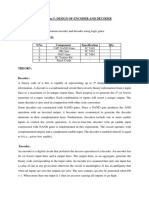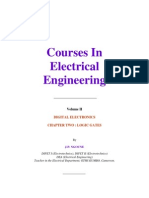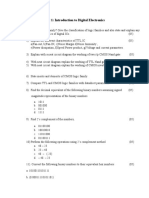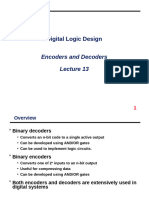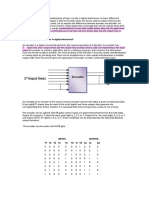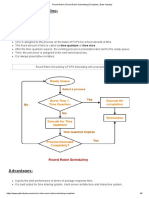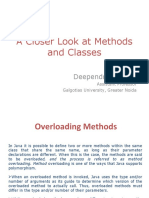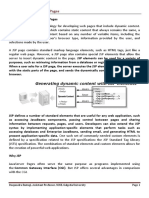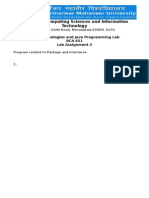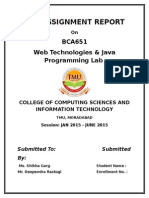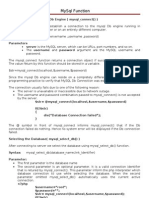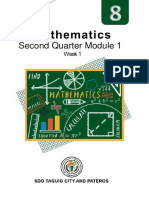Decoder and Encoder
Uploaded by
sankulsybcaDecoder and Encoder
Uploaded by
sankulsybcaDecoder and Encoder
Decoders Discrete quantities of information are represented in digital systems with binary codes. A binary code of n bits is capable of representing up to 2 n distinct elements of the coded information. A decoder is a combinational circuit that converts binary information from n inout lines to a maximum of 2 n unique output lines. The decoders presented here are called ntom line decoders, where m !2n. Their purpose is to generate the 2n minterms of n input variable. The name decoder is also used in con"uction with some code converters as a #$Dtoseven segment decoders. A binary decoder converts coded inputs into coded outputs, where the input and output codes are different and decoders are available to %decode% either a #inary or #$D &'(2) code* input pattern to typically a Decimal output code. An example of a 2+to+( line decoder along with its truth table is given below. ,t consists of an array of four -A-D gates, one of which is selected for each combination of the input signals A and #.
,n this simple example of a 2+to+( line binary decoder, the binary inputs A and # determine which output line from D. to D/ is %0,10% at logic level %)% while the remaining outputs are held %234% at logic %.% so only one output can be active &0,10* at any one time. Therefore, whichever output line is %0,10% identifies the
Page )
Decoder and Encoder
binary code present at the input, in other words it %de+codes% the binary input and these types of binary decoders are commonly used as Address Decoders in microprocessor memory applications. As an example consider the /to' line decoder circuit of fig. The three inputs are decoded into eight outputs, each output representing one of the minterms of the / input variables. The three inverters provide the complement of the inputs, and each one of the eight A-D gates generates one of the minterms. A perticuler application of this decoder would be a binarytooctal conversion. The input variable may represent a binary number, and the outputs will then represent the eight digits in the cotal number system. 0owever a /to' line decoder can be used for decoding any /bit code to provide eight outputs one for each element of the code.
Page 2
Decoder and Encoder
Page /
Decoder and Encoder
5ome binary decoders have an additional input labelled %6nable% that controls the outputs from the device. This allows the decoders outputs to be turned %3-% or %377% and we can see that the logic diagram of the basic decoder is identical to that of the basic demultiplexer. Therefore, we say that a demultiplexer is a decoder with an additional data line that is used to enable the decoder. An alternative way of loo8ing at the decoder circuit is to regard inputs A, # and $ as address signals. 6ach combination of A, # or $ defines a unique address which can access a location having that address.
5ometimes it is required to have a Binary Decoder with a number of outputs greater than is available, or if we only have small devices available, we can combine multiple decoders together to form larger decoder networ8s as shown. 0ere a much larger (+to+)9 line binary decoder has been implemented using two smaller /+to+' decoders.
Page (
Decoder and Encoder
Page :
Decoder and Encoder
Encoder An encoder is a device, circuit, transducer, software program, algorithm or person that converts information from one format or code to another. The purpose of encoder is standardization, speed, secrecy, security, or saving space by shrinking size. Encoders are combinational logic circuits and they are exactly opposite of decoders. They accept one or more inputs and generate a multibit output code. Encoders perform exactly reverse operation than decoder. An encoder has M input and output lines. !ut of M input lines only one is activated at a time and produces e"uivalent code on output lines. #f a device output code has fewer bits than the input code has, the device is usually called an encoder.
Page 9
Decoder and Encoder
$or an %&to&' binary encoder with inputs #(&#) the logic expressions of the outputs *(&*+ are, *( - #. / #' / #0 / #) *.- #+ / #' / #1 / #) *+ - #2 / #0 / #1 /#)
Page ;
Decoder and Encoder
Page '
You might also like
- Guide & Workbook: It'S Worth The EnergyNo ratings yetGuide & Workbook: It'S Worth The Energy13 pages
- Encoder, Decoder, Multiplexers and DemultiplexersNo ratings yetEncoder, Decoder, Multiplexers and Demultiplexers39 pages
- 4b Digital System - Logic Gates & Boolean ExpressionNo ratings yet4b Digital System - Logic Gates & Boolean Expression52 pages
- Slide 4 Rules of Boolean Algebra and Simplification100% (1)Slide 4 Rules of Boolean Algebra and Simplification53 pages
- Encoder, Decoder, Multiplexer, de MultiplexerNo ratings yetEncoder, Decoder, Multiplexer, de Multiplexer16 pages
- Encoders and Multiplexer Circuits: by Dr. Nermeen TalaatNo ratings yetEncoders and Multiplexer Circuits: by Dr. Nermeen Talaat22 pages
- Courses in Electrical Engineering: Digital Electronics Chapter Two: Logic GatesNo ratings yetCourses in Electrical Engineering: Digital Electronics Chapter Two: Logic Gates19 pages
- DF GTU Study Material Presentations Unit-2 11082020085346AMNo ratings yetDF GTU Study Material Presentations Unit-2 11082020085346AM83 pages
- Digital Logic Design Ali Saleh Normal Form Sop/PosNo ratings yetDigital Logic Design Ali Saleh Normal Form Sop/Pos11 pages
- Question Bank: Srinivasa Institute of Engineering and Technology100% (2)Question Bank: Srinivasa Institute of Engineering and Technology45 pages
- DKT 122 - Digital System I (April 2008)No ratings yetDKT 122 - Digital System I (April 2008)15 pages
- 10-Multiplexers and Demultiplexers LectureNo ratings yet10-Multiplexers and Demultiplexers Lecture44 pages
- Reference Lab Manual: CSC302 - Digital Logic Design and Analysis100% (1)Reference Lab Manual: CSC302 - Digital Logic Design and Analysis72 pages
- Lecture:15-17 Memory Interfacing in 8085: Course Instructor: Dr. KhuraiNo ratings yetLecture:15-17 Memory Interfacing in 8085: Course Instructor: Dr. Khurai24 pages
- The Digital Encoder: 4-To-2 Bit Binary EncoderNo ratings yetThe Digital Encoder: 4-To-2 Bit Binary Encoder10 pages
- Linear Algebra Updated Mid Paper Spring 20210% (1)Linear Algebra Updated Mid Paper Spring 20213 pages
- Encoder and Decoder: A Project By:Priyanka Basak 3Rd Year, 6th Sem Roll:32No ratings yetEncoder and Decoder: A Project By:Priyanka Basak 3Rd Year, 6th Sem Roll:3213 pages
- Round Robin - Round Robin Scheduling - Examples - Gate VidyalayNo ratings yetRound Robin - Round Robin Scheduling - Examples - Gate Vidyalay6 pages
- Priority Scheduling - CPU Scheduling - Examples - Gate VidyalayNo ratings yetPriority Scheduling - CPU Scheduling - Examples - Gate Vidyalay4 pages
- Unit 1 A Closer Look at Methods and Classes100% (2)Unit 1 A Closer Look at Methods and Classes21 pages
- Longest Job First Algorithm - LRTF Scheduling - Gate VidyalayNo ratings yetLongest Job First Algorithm - LRTF Scheduling - Gate Vidyalay4 pages
- A Closer Look at Methods and Classes: Deependra RastogiNo ratings yetA Closer Look at Methods and Classes: Deependra Rastogi21 pages
- College of Computing Sciences and Information TechnologyNo ratings yetCollege of Computing Sciences and Information Technology1 page
- C Programs: 1. Write A C Program To Determine The Sum of Odd and Even NumbersNo ratings yetC Programs: 1. Write A C Program To Determine The Sum of Odd and Even Numbers16 pages
- Medium Voltage Circuit Breaker Course 4.0 Student Manual Circuit Breaker CubicleNo ratings yetMedium Voltage Circuit Breaker Course 4.0 Student Manual Circuit Breaker Cubicle8 pages
- Learners Guide For Fully Online LearningNo ratings yetLearners Guide For Fully Online Learning32 pages
- Ittadi Network, B.Baria-3400.: Proposal Prepared ForNo ratings yetIttadi Network, B.Baria-3400.: Proposal Prepared For8 pages
- Keywords: Registration System, Development100% (1)Keywords: Registration System, Development31 pages
- Smartfren LTE Rollout Project Quick SSV Report: City: Site Name: SF Site Id: Zte Site Id: TechnologyNo ratings yetSmartfren LTE Rollout Project Quick SSV Report: City: Site Name: SF Site Id: Zte Site Id: Technology5 pages
- Project Title: Online Banking Introduction of The Project:: Generate Reports at Every SectionNo ratings yetProject Title: Online Banking Introduction of The Project:: Generate Reports at Every Section3 pages
- Temario Analisis y Diseño de Sistemas InformaticosNo ratings yetTemario Analisis y Diseño de Sistemas Informaticos2 pages
- Banking and Insurance Law Assignment (Abhinav)No ratings yetBanking and Insurance Law Assignment (Abhinav)18 pages
- West Hollywood Chamber of Commerce Newsletter Fall 2010No ratings yetWest Hollywood Chamber of Commerce Newsletter Fall 201016 pages
- Instant Download Challenges to Internal Security of India ( Includes Disaster Management) Ashok Kumar PDF All Chapters100% (8)Instant Download Challenges to Internal Security of India ( Includes Disaster Management) Ashok Kumar PDF All Chapters52 pages
- Term Project: Simulation of Different Protocols Using Cnet Network SimulatorNo ratings yetTerm Project: Simulation of Different Protocols Using Cnet Network Simulator14 pages
- 4b Digital System - Logic Gates & Boolean Expression4b Digital System - Logic Gates & Boolean Expression
- Slide 4 Rules of Boolean Algebra and SimplificationSlide 4 Rules of Boolean Algebra and Simplification
- Encoders and Multiplexer Circuits: by Dr. Nermeen TalaatEncoders and Multiplexer Circuits: by Dr. Nermeen Talaat
- Courses in Electrical Engineering: Digital Electronics Chapter Two: Logic GatesCourses in Electrical Engineering: Digital Electronics Chapter Two: Logic Gates
- DF GTU Study Material Presentations Unit-2 11082020085346AMDF GTU Study Material Presentations Unit-2 11082020085346AM
- Digital Logic Design Ali Saleh Normal Form Sop/PosDigital Logic Design Ali Saleh Normal Form Sop/Pos
- Question Bank: Srinivasa Institute of Engineering and TechnologyQuestion Bank: Srinivasa Institute of Engineering and Technology
- Reference Lab Manual: CSC302 - Digital Logic Design and AnalysisReference Lab Manual: CSC302 - Digital Logic Design and Analysis
- Lecture:15-17 Memory Interfacing in 8085: Course Instructor: Dr. KhuraiLecture:15-17 Memory Interfacing in 8085: Course Instructor: Dr. Khurai
- Encoder and Decoder: A Project By:Priyanka Basak 3Rd Year, 6th Sem Roll:32Encoder and Decoder: A Project By:Priyanka Basak 3Rd Year, 6th Sem Roll:32
- Round Robin - Round Robin Scheduling - Examples - Gate VidyalayRound Robin - Round Robin Scheduling - Examples - Gate Vidyalay
- Priority Scheduling - CPU Scheduling - Examples - Gate VidyalayPriority Scheduling - CPU Scheduling - Examples - Gate Vidyalay
- Longest Job First Algorithm - LRTF Scheduling - Gate VidyalayLongest Job First Algorithm - LRTF Scheduling - Gate Vidyalay
- A Closer Look at Methods and Classes: Deependra RastogiA Closer Look at Methods and Classes: Deependra Rastogi
- College of Computing Sciences and Information TechnologyCollege of Computing Sciences and Information Technology
- C Programs: 1. Write A C Program To Determine The Sum of Odd and Even NumbersC Programs: 1. Write A C Program To Determine The Sum of Odd and Even Numbers
- Medium Voltage Circuit Breaker Course 4.0 Student Manual Circuit Breaker CubicleMedium Voltage Circuit Breaker Course 4.0 Student Manual Circuit Breaker Cubicle
- Ittadi Network, B.Baria-3400.: Proposal Prepared ForIttadi Network, B.Baria-3400.: Proposal Prepared For
- Smartfren LTE Rollout Project Quick SSV Report: City: Site Name: SF Site Id: Zte Site Id: TechnologySmartfren LTE Rollout Project Quick SSV Report: City: Site Name: SF Site Id: Zte Site Id: Technology
- Project Title: Online Banking Introduction of The Project:: Generate Reports at Every SectionProject Title: Online Banking Introduction of The Project:: Generate Reports at Every Section
- Temario Analisis y Diseño de Sistemas InformaticosTemario Analisis y Diseño de Sistemas Informaticos
- West Hollywood Chamber of Commerce Newsletter Fall 2010West Hollywood Chamber of Commerce Newsletter Fall 2010
- Instant Download Challenges to Internal Security of India ( Includes Disaster Management) Ashok Kumar PDF All ChaptersInstant Download Challenges to Internal Security of India ( Includes Disaster Management) Ashok Kumar PDF All Chapters
- Term Project: Simulation of Different Protocols Using Cnet Network SimulatorTerm Project: Simulation of Different Protocols Using Cnet Network Simulator














